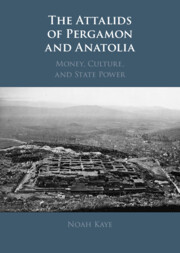Figures
2.1The Roman Via Sebaste, retracing an earlier Attalid route, emerges from the Klimax Pass (Döşeme Boğazı) into the plain of Pamphylia
3.1Silver tetradrachm of Eumenes II minted in the name of Philetairos
3.2Silver tetradrachm of Side minted ca. 210–190 BCE, bearing countermark of bow-in-case + ΠΕΡ
3.3Cistophoric silver tetradrachm of Pergamon, ca. 160–150 BCE
3.6Standing serpent on reverse of large module (hemiobol?) bronze coin in the name of Philetairos, ca. 270s–200 BCE
3.7Fragmentary bedroom scene from the Telephos Frieze with standing serpent warning hero and Auge
3.9Silver tetradrachm in the name of Athena Nikephoros, reign of Eumenes II, ca. 180–165 BCE
3.10Silver drachm of Ephesus with legend “of the Ephesians,” ca. 150 BCE
3.11“Wreathed” silver tetradrachm of Myrina, ca. 160–135 BCE
3.12Cistophoric silver tetradrachm of Ephesus, ca. 150–140 BCE
3.13Proconsular cistophoric silver tetradrachm, signed by C. Pulcher and Aristokles, 55–53 BCE
4.1Hellenistic grave stele of Doidalses from Mustafakemalpaşa
4.2The Çan Sarcophagus from the Granikos Valley, early fourth century BCE
5.1Plan of the gymnasium of Pergamon in relation to adjacent monuments and current reconstruction of street grid
5.2Gymnasium of Pergamon, looking east across the palaistra of the upper terrace
5.3Hellenistic Sikyon, view east/southeast from the terraces of the city’s gymnasium toward the adjacent agora
6.2View to the southwest of the Kaikos Valley from the acropolis of Pergamon
6.5Archaic terrace walls of Sardis, reconstruction drawing by Philip Stinson
6.7Late Hellenistic Pergamene market building of the unidentified city at Melli in Pisidia
6.8Late Hellenistic frieze of Gigantomachy in the agora of the unidentified city at Melli in Pisidia
6.9Left: reverse of silver tetradrachm of Demetrios II depicting Athena Magarsia, ca. 145–142 BCE; right: reverse of silver tetradrachm in the name of Athena Nikephoros, reign of Eumenes II, ca. 180–165 BCE

